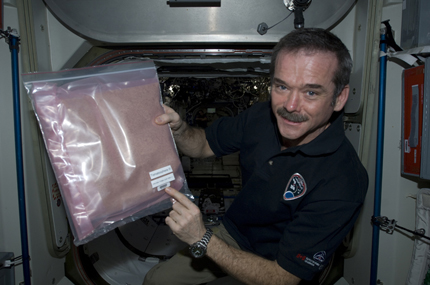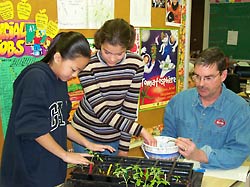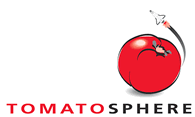Tomatosphere is an educational outreach project that reaches over 17 000 classrooms across Canada, the United States and several other nations. In 2015, teachers of students in grades 2-10 will receive two different types of seeds labelled "A" and "B" - a control group - and the other is the "treatment" group, which was subjected to a simulated space environment of -80°C in a vacuum at the University of Guelph for a 34 day period. The simulation approximates what might happen to the seeds if there was a breach in the storage system on a spacecraft with astronauts going to Mars for the first time.
Purpose
 Tomatosphere
has a dual-purpose: to educate and inspire young students and to
open the door for extended space exploration, eventually leading to Mars.
Tomatosphere
has a dual-purpose: to educate and inspire young students and to
open the door for extended space exploration, eventually leading to Mars.
The students' findings will address the question of how we supply space exploration missions with life support requirements food, water, oxygen and the need to consume carbon dioxide exhaled by the members of the crew. Currently, space-mission vehicles are able to carry just enough of these requirements to service the crew for short missions. Stays at the International Space Station are refreshed on a regular visit by supplies from Earth such as the Russian Progress and Soyuz flights and US Discovery flight (STS-114) Travelling to and from Mars, the closest planet to Earth, may take in excess of two years. To have adequate food supplies for survival on Mars, astronauts will need to grow some of their own food. The tomato is one of the candidate crops for a farm on Mars.
In our quest to travel deeper into space for extended periods, we need to find ways to expand life support provisions in the limited room available in space vehicles. A plant-based life support system may provide part of the solution. Through photosynthesis, plants use light energy to consume carbon dioxide exhaled by humans and return oxygen to the air that is needed for survival. One of the most popular and valuable plants for space applications is the tomato. Tomatoes provide wholesome nourishment and purified water through transpiration from their leaves.
Seeds in Space
By sending tomato seeds on a shuttle mission, exposing them to conditions which may reflect conditions experienced on a Mars mission, or having them housed at the International Space Station for an extended period of time, researchers can determine if and how the seeds are affected by environmental conditions. This will help to determine which types of seeds have the highest potential for germination and growth in space. Because space is so critical, the number of plants that can be grown and the number of people who can be supported for extended time periods, is limited. When a seed - and the plant that grows from it - is assigned to a space mission, it must germinate successfully and continue to grow healthy, strong and with an abundance of fruit. Seeds that don't germinate, and plants that are weak - and don't grow properly - are not contributing to the mission. Weak plants may also become sick and contaminate the controlled environment system.
Students will compare the rates of germination and may report on the growth and development of the plants from the seeds from the two different conditions. Students will learn how to conduct a scientific experiment and hopefully will be inspired to pursue further education in the areas of science and technology.
Curriculum Focus
- In grade six, the emphasis is on human needs, weather and space;
How will the project proceed?
 In
the spring of 2015, the fourteenth phase of the current Tomatosphere Project
will take place.
In
the spring of 2015, the fourteenth phase of the current Tomatosphere Project
will take place.
Students will observe the tomatoes during their seedling germination and growth. The scope of the experiment will depend on the teacher; there are extension ideas that involve many aspects related to plants, space and space travel, and its application to life on Earth. However, the project focuses on the critical elements of the date of planting the seeds, date on which the first seed germinated in each group, date on which the last seed germinated in each group, and the total number of seeds germinated in each group. All results will be sent electronically to the Tomatosphere website ( www.tomatosphere.org ) and will be posted to enable participants to compare their results with those of other classrooms across the country.
Sponsors
Tomatosphere is sponsored by H.J.
Heinz Company of Canada Ltd. , the Canadian
Space Agency, Ontario
Centres of Excellence-Centre
for Research in Earth and Space Technology (CRESTech), Agriculture
and Agri-Food Canada, Stokes
Seeds, and the University
of Guelph.
